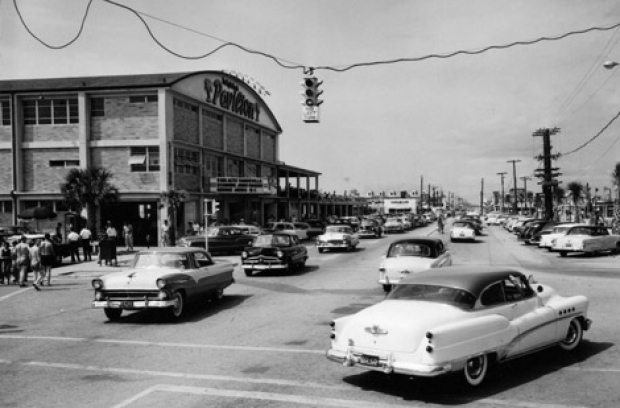Camera in hand, Jack Thompson has immortalized Myrtle Beach in thousands of pictures, one click at a time

Jack Thompson sorts through stacks of his black-and-white photographs—some framed, some loose or mounted on boards—in his storefront studio on Broadway Street. It’s his fifth location in as many decades, always in buildings within a sea-breeze distance of the Myrtle Beach Pavilion. (Or nowadays, the empty grass lot and beach where the Pavilion once stood.)
In these blocks that are the historic heart of Myrtle Beach, Thompson, 73, and his photographs help remind people of the city’s beginnings, particularly of the classic mid-century era. Decades after he snapped his first photographs of the Grand Strand, Thompson’s still-growing collection of prints are striking, classic, even iconic—and they have grown to become his legacy: black and whites, largely, the faces and scenes look of a simpler past, one you could simply step into.
His career was begun during this same era, when, with two other teenaged boys from his hometown of Greenville, South Carolina, Thompson rode in farmers’ truck beds and on un-airconditioned buses to get to Myrtle Beach. (The boyhood friends who joined him were Freddie Collins, who’d later become a millionaire in the business of poker machines and other amusements; and Carroll Campbell, who’d one day be governor of South Carolina.) The boys had heard stories from older friends back in Greenville of the sandy lifestyle—of the beach music, beer, and beautiful girls to be found. After several days of often-misdirected travel on two-lane highways (including mistakenly catching a ride to Orangeburg, and then up to Society Hill where they slept one night under a church), Thompson says the three finally arrived in downtown Myrtle Beach, exhausted, hungry, and broke.
He remembers that day well. Thompson says he could see the Pavilion from the bus stop, and walked directly to it. The year was 1951, and in his first few hours in the beach town he’d dreamt of, the thirteen-year-old runaway found work helping the photo booth photographer at the Pavilion take souvenir
pictures of tourists. Campbell and Collins were soon retrieved by relatives and returned home. But Thompson wanted to stay. And when one of his older brothers, Joe Thompson, was sent down to Myrtle Beach to take him home to Greenville, Joe ended up finding a girlfriend and a job at the beach. Together, the brothers convinced their parents to let them stay to work and to finish school at Myrtle Beach High. By 1959, Jack Thompson opened his first photo studio in a building that once housed the Myrtle Beach Chamber of Commerce.
Today, when he speaks of his work, Thompson is a mix of humble and proud. And he’s quick to say that the subjects are often “ordinary” scenes. “Now people say, ‘Jack, you must have been a damn genius.’ But if I was, I didn’t know it at the time. These pictures are of what was everyday. . . . It was just the way it was.”
Thompson credits his father, Greenville News editor Jimmie Thompson, for telling him that it was important “to record everything he could” through his photography. The younger Thompson says that from an early age, he always ended up in the newspaper’s darkroom when he visited his father at work. And on that first day in Myrtle Beach back in 1951, he says it was the familiar smell of darkroom chemicals that attracted him to the photo booth at the Pavilion.
Perhaps it’s because more and more classic Myrtle Beach landmarks are disappearing, but there’s been a flurry of interest in recent years in Thompson’s collection of images. He has shown his work in solo exhibits at the Burroughs and Chapin Art Museum in Myrtle Beach and the Horry County Museum in Conway. And in 2003, he published a collection of his photographs in a coffee table book titled Memories of Myrtle Beach. He’s now a board member and vice chairman of the Horry County Museum, and he’s been working on a longer book that will include his research and perspectives on the development of Myrtle Beach.
He estimates he’s taken more than 100,000 photographs during the second half of Myrtle Beach’s 110-year civic history. And historically, one of his most important and famous photographs is of the demolition of the grand Ocean Forest Hotel, which had opened to national fanfare in 1930 and was torn down in 1973 to make way for an oceanfront condominium development. “When I was there that day, and I found myself setting up my camera on a strategic sand dune, I knew in my heart that the governor, the mayor, or the fire chief or somebody was going to come in and stop the demolition, because of what this hotel meant to this part of this state,” Thompson recalls. “Then I heard the first explosion, and I started crying. . . . I had grown up in that hotel, photographing famous personalities and conventions night after night. I could not believe that men of vision did not step in and save it.”
He was reminded of that day again in the 1990s when the circa-1937 Myrtle Beach Train Depot building was under threat of being torn down. Thompson was instrumental in the fundraising effort to preserve and restore the brick building, which reopened in 2004 and is now permanently protected as a historic site and meeting place.
These days, Thompson remains one of Myrtle Beach’s fondest admirers. He knows the city has a reputation for continually reinventing itself, yet he’s cautiously optimistic about the future. He was disappointed at the recent closing and demolition of the centrally located Myrtle Square Mall, and especially of the loss of the eleven-acre Myrtle Beach Pavilion & Amusement Park. “The powers that be destroyed a magical place. . . . It’s a heartbreak and a tragedy.” The big question is, he says, “How do you put the genie back in the bottle?”
Photographs Courtesy of the Brittain Family